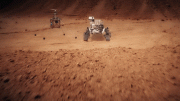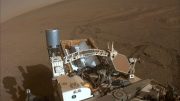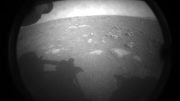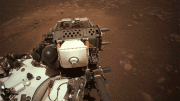“When you look at the team that put this robot together, and the team that put this launch vehicle together, that’s what they’ve done. They’ve persevered.” Go behind the scenes of our Perseverance Mars rover’s July 30, 2020 launch with NASA Administrator Jim Bridenstine. On February 18, 2021, the rover will land in Jezero Crater, Mars, where it will search for signs of ancient life.
Video transcript:
Well here we are at the Kennedy Space Center, literally four days away from launching Perseverance to Mars.
But we’re also gonna have Ingenuity with it. We’re gonna fly a helicopter on another world for the first time in human history.
So many exciting things happening.
And we want you to come with us on this experience, not just for the launch, but for the entire mission, because there is so much discovery ahead of us.
So you can see the launchpad over there that looks like an upside-down L. That’s the launchpad that we use for our Atlas V launches. And it’s a — it’s the same launchpad that we use for Starliner. And of course, now we’re gonna launch Mars Perseverance from the same launchpad.
The thing that I’m most excited about is that this is the first mission we’ve ever done that is designated for astrobiology.
Yeah.
The idea that we are, no kidding, designating a rover to look for signs of past life on Mars.
And as you said, it’s our first astrobiology mission. We really wanna go after and identify if there were actually these early fossils of microbes.
We wanna look for those — where we wanna drill, the most likely places to get those samples, so we can bring ’em back to Earth because we’ve got the best instruments on Earth, where we can do incredible analyses on those rocks when we get them back here.
So it’s really our first return trip adventure to another planet.
It’ll be the first time we’ve ever done a complete round trip to another planet. It’ll be the first time that we launch a rocket from the surface of another planet.
And all of those things conspire to say that maybe at one time, Mars could have hosted life. And now we’re actually gonna go and try to make those discoveries.
You’re the head planetary scientist at NASA. What is it that has you the most excited about this mission?
I am so excited to start exploring that river delta in Jezero.
I cannot wait to get there, and drive up to that delta, and taking our first look at it, and seeing what’s in there, what’s in those rocks. I think that’s gonna be phenomenal.
So there’s so many things that are exciting about this mission, but, you know, there’s a helicopter involved in this mission, which is the first time we’ve ever tried to fly a helicopter on another world. But what does the helicopter give us?
I think the helicopter is just amazing technology, amazing ingenuity, which is its name. A very appropriate name for the helicopter. It’s really incredible.
And you, as a pilot, I know understand just how hard it is to achieve flight on Mars. And what’s really cool about that is it’s gonna give us insight into the future of what we could do.
So I think the powered flight is gonna be something that changes the way we think about doing exploration on Mars.
We have all witnessed COVID. And… we watched the world stop.
Jim and I both just so amazed at your workforce, our workforce. And to continue during COVID.
And they have worked and been so incredibly dedicated, really done an amazing job, and it’s inspirational.
It is inspirational. It’s aspirational.
Yeah.
And as a team, we came together. And here we are in the middle of a pandemic, the worst in 100 years, and we’re still going, “We’re gonna do it!”
[chuckles] That’s so exciting to me. This has been great. I’ve learned so much.
Good. – And I appreciate both Jim and Lori. Thank you.
Well, awesome. Lori, thank you for all your time today.
Thanks, Jim.
Hi! – Hi, how are you?
Good. How are you?
[indistinct] – Same here! Elbow bump? Yeah! [laughs] – There you go.
What I love about NASA is that it — — it’s one of those things that unites people. It brings people together. When you look at the team that put this robot together and the team that put this launch vehicle together, that’s what they’ve done.
They’ve persevered. – So, yeah. This is where the magic happens.
Fantastic. – Yeah.
So tell me what you’re working on here.
So we’ve taken over 15,000 samples of the spacecraft over time.
Okay.
Each sample is taken. It’s sonicated. It’s heat shocked in a water bath at 80 degrees Celsius. And we search for specific endospores, bacterial endospores, because those are the things that have the highest potential of surviving the journey from here to Mars.
Right.
And the reason why we do that is because we don’t wanna contaminate Mars…
Right. – With our Earth bacteria.
So a lot of people hear “planetary protection.”
Yeah.
But your word there, “contamination.” That’s really what we’re trying to prevent. Planetary protection is all about keeping the science as pure as possible… – Mm-hmm. – So that when we do make discoveries, we know that they are, in fact, discoveries.
Exactly. Wow. You can just take over this job.
[both laughing]
I’ll leave the science to you.
So these are actually samples from the Windbreaker that goes over the MMRTG on the back of the rover. So that was just a few days ago.
Right, right. – Yeah.
MMRTG, that’s in essence, the fuel for the rover.
Exactly. So we were in there by the radiation source, taking those samples, and it came out really, really clean.
Awesome. – We actually have — we’re far, far below the requirements for the entire vehicle.
Awesome. Good, good, good.
So yeah. This is our next-to-last set of samples. We have our final set in the incubator. It’s from the payload launch fairing doors.
Okay. – And that’s it. The doors are on and it’s ready to launch.
Awesome. – It’s pretty exciting.
These are all very important things that you’re working on.
I actually have a 3D printed model…
Oh, wonderful. – Of the tube assembly if you wanna see. – Let’s go look at it. – It’s what the robotic arm on the inside of the rover uses to manipulate the tubes. And the tube itself.
The sample that we collect on Mars…
Uh-huh. – Goes in where?
Goes in here. – In this side here. So we have the sample in here. – Mm-hmm.
And it could be a rock. It could be some kind of soil. – Yes.
It could be whatever it is. And then you leave this… – Yeah.
On the surface of Mars… – Yeah.
For our 2026 mission… – Exactly.
Which is gonna go pick this up…
Yes. – And bring it back to Earth.
Yeah.
And just make sure we don’t bring any microbes back that are gonna hurt us, all right?
Got it. – All right.
You got my word. [laughs]
Thank you so much. – Oh, thank you!
All right. – Thank you.
30 seconds. – Hey, how are you?
So we just had the launch readiness review, and we are, in fact, go for launch. So it’s a very exciting time, and the press conference should be a lot of fun. But we are in fact gonna launch what we now call Mars Perseverance in the year 2020.
And we are in extraordinary times right now with the coronavirus pandemic. And yet, we have in fact persevered.
The most important thing that happens in these missions are the things we did not plan.
Really for the first time, we’re looking for signs of life on another planet.
And we are literally chomping at the bit to take this nuclear-powered dune buggy out to Mars.
Suppose we get to the Mars sample return and in fact we find irrefutable evidence of life existing on Mars. How will that change the Earth?
It’ll transform how we think about exploration. What comes next? What else can we discover?
And all the likelihoods that relate to life all went up. – Right.
There was no water there. There’s water everywhere, right?
So the more discoveries we make, the more we understand how much we don’t know.
Mm-hmm.
And how much more work there is to be done.
And the exciting part, of course, is to get humans there too. – Absolutely.
I mean, that will be a huge accelerator of research. Right? I mean —
But if we wanna do even more science, we need to have human exploration partner with us.
The exploration could be your body, could be human. But it’s exploration, right? – Right.
And we need to find the right ways. Thanks to you and for everything you’ve done. Especially during this COVID time. And we said it together. “Yes, we will make this 2020 launch.” We will put everything we can behind this team. And we did, you know?
Well, thank you for all your leadership, and we’ll look forward to a good launch.
Well, thanks to you.
Howdy.
Welcome to the RPSF.
We’re gonna go through — go in those side doors.
When humanity is multiplanetary, that’s kind of, I think, the vision that all of us who are interested in exploring space, that’s what we would like to see. What we do right now today is either going to enable or prevent that future.
We’re very proud to be a part of this.
Good.
These are all three programs coming together, all working every single day together.
As we put this rocket together, these are the solid rocket boosters that are gonna be attached to the Space Launch System, SLS, with the Orion capsule on top.
The solid rocket fuel is in there right now?
Yes, sir.
We’re gonna take that first woman and next man to the Moon.
How you doing, sir? – Hey! Good. How are you?
Pretty good. How about yourself, man?
I’m doing excellent.
That is one segment right there. There’s five segments. – Right.
And we’ll stack these rocket segments that you see here, these solid segments, on the mobile launcher.
Now — which is amazing. – It is!
You know, what’s so cool is, we’re here because we’re gonna launch Perseverance going to Mars.
Precursor for sending humans. – Exactly.
We’re building a sustainable architecture. The rover — Perseverance rover — Mars 2020 rover Perseverance, that is really hard. That is a huge challenge to get that onto the surface of Mars and have everything work, but that is nothing compared to putting humans down, ’cause humans — you gotta give ’em air to breathe.
You gotta scrub the CO2. You gotta provide a pressurized environment. You gotta take care of all their waste. You gotta give ’em food to eat.
People ask us, you know, why are you doing this? Why is this so important?
It’s about learning, about exploring, about going beyond what we currently know to make us even better. And I truly believe we as a species have to be able to live off our home planet. Huge challenge, but we’ve got an awesome team.
Thank you, Bob. – Thank you, sir.
All right.
So today we’re gonna watch this big rocket behind us, the Atlas V with the Mars Perseverance on top inside the fairing, roll out to the launchpad.
I’ve launched almost 400 rockets over my career, but I still get butterflies. Everything has to go right. Nothing can go wrong.
This particular rocket — it’s an Atlas V, of course, but there’s different versions of the Atlas V. This one is one of the more powerful versions.
So it has four massive solid rocket motors augmenting the already 860,000 pounds of thrust from the center core. And we call this one The Dominator.
[chuckles]
So, you know, the payload is big. But it’s not that big. Why do we need that much power?
We have to escape not just the gravity well of the Earth, but entirely escape its gravitational influence.
So right now, we’re witnessing this powerful Atlas V rocket come out of the Vertical Integration Facility, the VIF.
It is moving. This rocket is 20 stories high fully assembled. So the VIF allows it to assemble the rocket, integrate the spacecraft all in a protected, enclosed environment, and when it’s all ready, which it is now, we open the doors, and it’s rolling at us.
In fact, we better be careful. It’s a blistering 3 1/2 miles per hour, so we don’t wanna get surprised.
Right.
But in about 45 minutes,
it will traverse this several hundred yards out to the launchpad and then be ready to go to Mars in just about 48 hours.
It’s a lot bigger when it comes out of the VIF, huh?
Yeah, it is.
Here you go, Tory. – All right.
And I’ll tell you. The rocket looks big when it’s in the Vertical Integration Facility, but when it’s standing alone outside the building, that thing is massive when you’re right there next to it.
Man, it’s pretty… it’s pretty inspiring. It’s loud as well.
Yeah, so we’re heading over to do a brief for members of Congress, bipartisan brief. You know, in each one of these, we’re talking about billions of dollars of investments. We’re coming up on a few moments in time that are literally seconds long, but each one of those moments carries with it a good bit of risk.
Yeah, people talk about how exciting it is to watch a rocket launch.
Well… [chuckles]
You know, when you’re in charge of an agency that just spent $2 1/2 billion of taxpayer money on a robot, and a helicopter, and scientific experiments, and technology demonstrators that are going to Mars, it is… it makes it even more exciting just from a — a, you know, personal pride, you know?
I wanna make sure that the missions that we do are — we’re doing everything we can to make them safe and, of course, successful. We’ve invested a lot into this project. The science is gonna be absolutely remarkable that we get from it.
And that we’re very grateful for all the support we’ve had from bipartisan members of Congress. And I look forward to the results of this.
We’re not struggling to survive. What we’re struggling to do is strive. Perseverance is how you achieve. It’s how you move forward. It’s how you make your life and the lives of others better.
Hello, Mr. Bridenstine.
Alex, Vaneeza, how are you? – Good.
Good. How are you? – Good.
Well I just wanna tell both of you that we are so grateful that you are this excited about what NASA is doing that you decided to put forward names for our rover and our helicopter.
There will be science books and history books written about Perseverance and Ingenuity. And for the rest of your lives, you will know that those are the names that you two gave.
So my goal was to answer the question of how, like how is it possible to do something as incredible as do science on another planet? And I thought ingenuity was a quality that represented that intelligence and creativity best.
I was just thinking about what makes space possible and what makes space human. And not just space, but all aspects of human life. What just sums up our species?
And when I thought of perseverance, it just — it fit.
Well what was amazing is, you came up with the name Perseverance even before the pandemic. It’s a remarkable name in itself, and even more appropriate now that we are in these very difficult times.
And the fact that we’re looking for signs of life, I think that’s really exciting. And that a new technology that’s like, never been tried before is gonna be tested, I think it’s going to be really impressive if flight can be pulled off on another world.
Now, do you think we’ll find life?
Maybe. I’m going with strong maybe.
You’re going with strong maybe? Cautiously optimistic? – Yeah.
Personally, I’m really into the whole sample return system. It looks like a bunch of satellites playing catch in space.
[chuckles]
And that’ll be fun to see happen.
Yeah.
And of course, after sample return, what’s the next thing we need to do?
Get us some humans on Mars.
Okay.
Being able to see people on another planet would be incredible.
So how exciting is it for you to be here, to experience this launch, and what are you expecting?
I’m expecting something big, something loud, something bright, but most of all, something that is beautiful.
It is fantastic to be here at the Kennedy Space Center. We are less than 24 hours away from a launch to Mars.
Our workforce has done an amazing job. Here we are. We’re launching to Mars in the middle of a pandemic.
So this is the first time in history where we’re gonna go to Mars with an explicit mission to find life on another world.
I can think of maybe no more profound question than the question of whether there’s life on another planet. And, you know, this, when it touches down, is going to be the best scientist we’ve ever sent to the planet to answer exactly those questions.
The big screen behind me — that’s the countdown clock.
Everything is good. The spacecraft is a go. The rocket is a go. The weather is a go. And as the NASA administrator, I’m thrilled that we are able to come to this point where we’re ready to launch it.
If we’re not letting people know why we’re doing what we’re doing, we’ll miss out on the opportunity to continue to stun the world with these amazing achievements.
I mean, this is the stuff of science fiction books. People have been speculating what Mars was like now since the beginning of time. But if you look at the Mars missions that we’ve done in the past, one builds upon the other.
This will be the ninth robot that we land on Mars. We do know that Mars, at one point in its history, was habitable. It looked a lot like Earth about 3 billion years ago.
So these are questions that I think are fundamental that we need to have answered. We’re gonna cache those samples, and we’re eventually gonna do a Mars sample return mission. We’re gonna bring those samples back to Earth. But there’s so much more going on here.
We’re just getting started.
The stage adaptor is on that barge. That’s gonna be the rocket that takes our astronauts to the Moon. We’re putting together the most ambitious Moon project in the history of the world. This generation is the Artemis generation.
We as a species are explorers.
So the answer is yes, we can do it. We’re gonna prove on this mission that we can take the carbon dioxide of Mars and turn it into pure oxygen for life support. And the capabilities that we’re building on the Moon, we’re building with an intent to send humans to Mars. So as much as possible, we’re building capabilities that are replicable at Mars.
To bring hope and inspiration to the country and to the world. And we’re gonna continue to do that, because that’s what NASA’s here for.
And this is the thing that has me the most excited. Is the idea that we are gonna fly a helicopter on Mars.
Tomorrow, God willing, we’re gonna launch this rocket.
This is gonna be an inspirational moment, so stay tuned, and we will see you all tomorrow morning for the launch.
Thank you so much.
Thank you.
All right. Thank you, you guys.
Thanks, everybody.
all: Thank you!
In less than an hour, NASA’s 300 million-mile journey from America’s shore to Jezero Crater on Mars will begin with the launch of this Atlas V rocket.
You’re talking about taking a $2 1/2 billion payload that represents not just the treasure of the American taxpayer, but also thousands of people that have worked a big chunk of their lives.
This has been seven years in the making, and I’m so excited to share this moment with you and with those that are viewing today.
Every time we launch into space, it is nerve-wracking. There’s nothing at that point you’re gonna do to stop it. That rocket goes, it’s going.
Go, Atlas. Go, Centaur. Go, Mars 2020.
Here it comes.
Ten, nine, eight, seven, six, five, four, engine ignition, two, one, zero.
[rocket roaring]
And liftoff.
As the Countdown to Mars continues, the Perseverance of humanity launching the next generation of robotic explorers to the Red Planet.
Oh, man.
Here comes the noise.
[indistinct radio chatter]
Can you feel it inside?
[indistinct radio chatter]
The solid rocket motors are gonna fall off.
And we have good indication of SRB jettison of all four SRBs.
[laughing]
And the vehicle has gone to closed-loop guidance.
[cheers and applause]
Thank you.
Did you feel it?
Congratulations. – Thank you.
Congratulations so far.
Good work.
So first of all, it was an amazing launch. Very successful. [chuckles]
Can you be above nominal?
Right, so you know, this is the actual telemetry going into the model.
This launch of Perseverance today was just the beginning. There is so much more. Congratulations and good work to everybody that made it happen.
The launch is over. But this mission is gonna go on for years and years and years. When we land, it’s gonna be magnificent.
This mission has more cameras on it than any mission we’ve ever sent before it.
Those videos are gonna be absolutely stunning.
It’s a space mission now, right? And it’s on the way to Mars.
Stay tuned. February 18th. Watch this spacecraft enter, descend, and land on the surface of Mars.
And then ultimately, you know, we’re gonna do the science to make the discoveries as to whether or not there might have been life on Mars in its ancient past.
Congratulations. Go Perseverance.







Wish that they will soon find life on Mars. I still have the stamp sets…….Monument on Mars. If they find something maybe I’ll get rich overnight??.